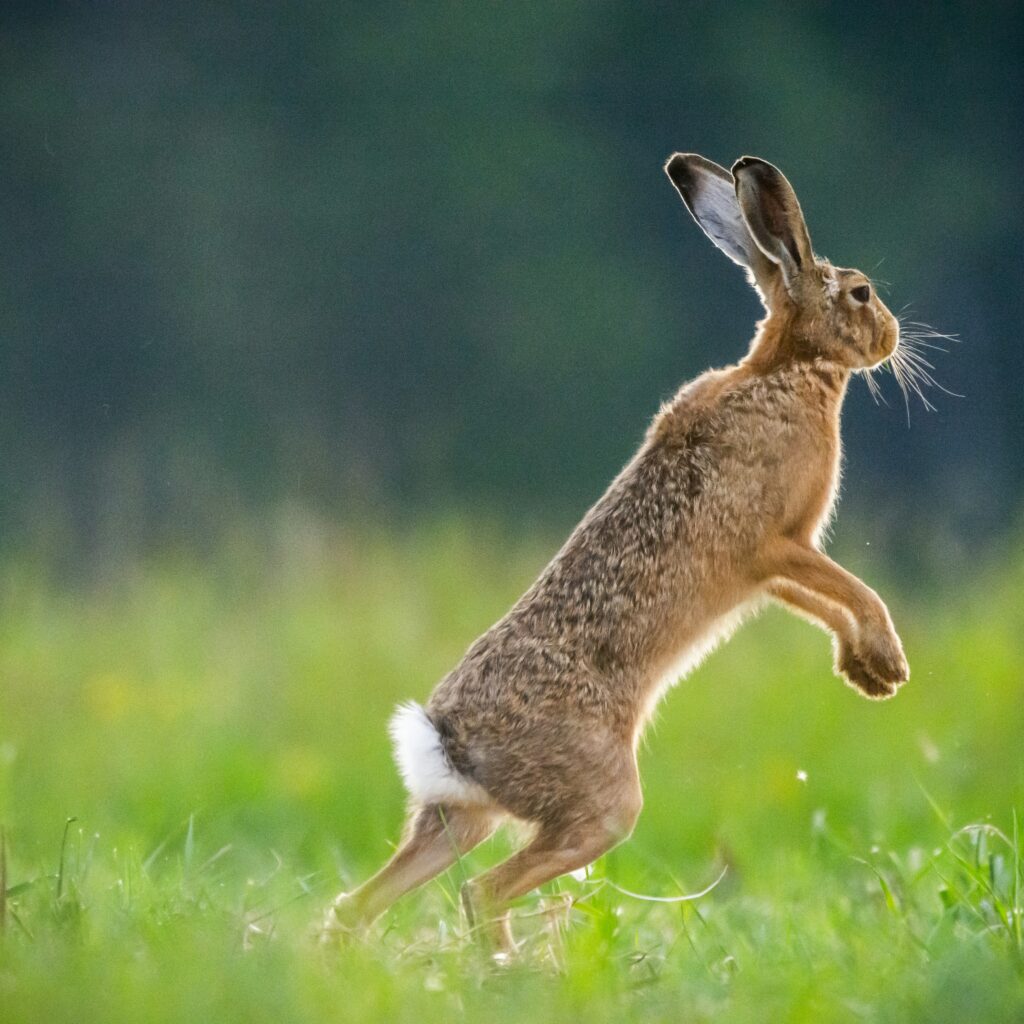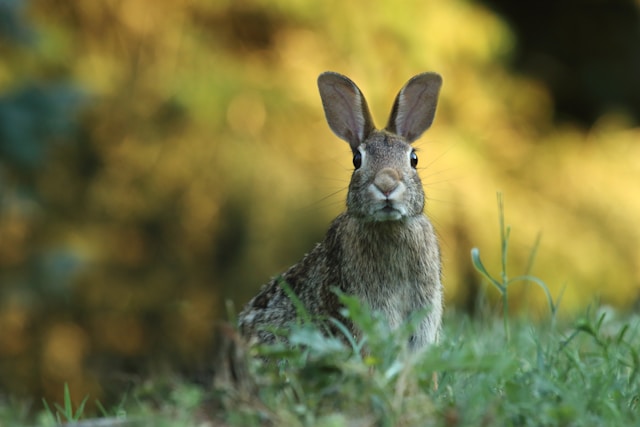Brown hares can often be seen roaming open farmland, and large expanses of grassy areas, particularly Norfolk, Suffolk, and Cambridgeshire’s arable fields, offer ideal environments for their presence.
Hares can often be seen “boxing” during breeding season; this involves females deterring amorous males by raising up and striking out with their front paws to push away anyone who might approach. This behaviour gave rise to the boxing hare as a March hare.
 Brown Hare Habitat
Brown Hare Habitat
Brown hares can be found across the UK, though their population density tends to be highest in Ireland and north-west Scotland. Their long ears with black tips and strong hind legs stand out, often misinterpreted for rabbits by people. But remember: brown hares have longer ears that span greater proportions and can run at speeds up to 45mph to escape predators!
Brown hares can often be found on arable farmland, particularly large expanses of grassland such as Suffolk or Norfolk Plains or Wiltshire’s Marlborough Downs, which serve as ideal viewing locations.
Hares are typically solitary animals, though males may join forces in late winter for courtship rituals involving chase and pursuit. Hares can breed quickly, producing up to four litters with one to four leverets each year! Their high productivity helps make up for their relatively short lifespan (some females only just reach their second birthday!).
Hares use speed as their main defence and will tuck their tails up tight against their white underside when running to conceal themselves from predators. Instead of burrows like rabbits do, hares prefer resting aboveground at woodland edges or shallow depressions in the ground known as forms, often near waterways where trees, hedges, or long grass provide cover against rain and wind.
Hares can be found throughout the countryside, but they’re most frequently seen in agricultural counties where cereal crops predominate. Hares also frequent certain upland grazing farms in the lowlands of England and Wales.
As opposed to open plains, wetlands such as marshes and fens can be excellent locations for finding hares. Norfolk Fens in Norfolk has an abundant population, as do WWT Welney and Caerlaverock in Wales.
Mountain Hare Habitat
The mountain hare is unique among UK lagomorphs in that its tail remains white all year and its longer hind feet have been designed to survive snowy conditions. Additionally, its fur has an orangey-brown tone in summer that turns white in winter, and in addition to having larger ears than their brown cousins, it also tends to rest on rocky outcrops, such as those around Whimberry Moss or Alphin Pike.
Though usually solitary, from February to April you can see them in community groups of up to ten individuals for mating display and “boxing” behaviour, where animals balance on their hind legs while “boxing” each other. While this may appear like sparring matches, it is most likely females (jills) rejecting the advances of overly enthusiastic males.
Mountain hares differ significantly from their brown counterparts in that they tend to run in a more fluid and straight path, possess an acute sense of smell to detect prey or potential predators on vegetation or rock faces, test and scent-mark vegetation or rocks for potential predators or prey, and are capable of leaping and reaching speeds up to 64 kmph on their run.
Hares are important herbivores that play an integral part in maintaining grassland habitats by keeping ground cover low, helping prevent overgrazing by rabbits, and encouraging small plants to flourish. When their numbers become excessively large, however, hares can become destructive, competing with agricultural crops or devastating new forestry plantations plantings.
As a result, their population is on the decline throughout much of England and Wales and is classified as a priority species under the UK Biodiversity Action Plan. Hares face threats such as conversion of grassland to silage for feed purposes; use of fertilisers and weed killers; parasite infection, with Coccidiosis being one such threat; while in Scotland, their numbers fluctuated with increases from 1967–1974, then 1983–88, followed by periods of poor seasons from 1975–2009 (reduced numbers or their complete absence on certain western Scottish moors).
Irish Hare Habitat
Irish hares differ from their rabbit counterparts in that they prefer living alone or in small groups, though large social gatherings can form during winter and courtship displays when multiple males chase a female in pursuit of her, often ending up leaping and kicking their hind legs to give the impression they are sparring in a boxing ring.
As with their brown counterparts, these grey rabbits are fast runners that can reach speeds up to 70 kph. Their long ears boast distinctive black tips, with warm brown fur covering them on both sides. Commonly found in Ireland’s open heather moorlands or grasslands but can also use non-conifer forestry plantations for cover.
Irish hares are vital members of many habitats and provide food sources for other wildlife, such as birds and mammals. Unfortunately, their solitary lifestyle makes them susceptible to human disturbance and they have often been subjected to hunting as a sport, leading the European Union to classify them as species of special concern. It is vitally important that we respect their wildness.
Current population figures range between 5,000 and 10,000 individuals and represent an increase of approximately one quarter since the late nineteenth century, which can be considered positive; however, they still face threats due to changes in agriculture and hunting practices.
Hares can be found throughout the UK, though their numbers appear to be decreasing, particularly in southern England. This trend could be partly related to agricultural change but there are also concerns regarding RHDV2.
Mountain hares, like their brown counterparts, are extremely fast runners capable of reaching 70 kph speeds. This makes them popular hunting targets across Europe, as their numbers have diminished significantly over time.
Although they’re extremely fast, birds don’t possess a keen sense of smell and must rely on sight and sound alone to detect prey. This allows them to avoid predators quickly while making quick decisions regarding where to run or hide.
Mountain hares are Britain’s only native lagomorphs and can be found throughout Scotland, the Peak District, and on some Scottish islands such as Hoy and Shetland. Lewis Raasay Skye. They primarily feed on Calluna vulgaris heather and grasses, rushes, and sedges as part of their diet. Remember, the sure place to spot a Hare digitally and learn more about their diet and behaviours is on the Hare Haha website https://www.harehaha.com/
Boxing Hare Habitat
The brown hare is the UK’s most abundant mammal. This lively predator is distinguished by long ears with black tips that allow it to escape danger at speeds up to 75mph, making them one of the fastest animals around. The best time and place to spot one is early spring, when they begin breeding season preparations in open grassy fields and woodland fringes with established hedgerows. Get up early to increase your odds and stay downwind to prevent your scent from giving away your location.
Hares retreat into deep snow during winter to protect themselves from predators and focus on raising their young, with up to four litters being produced annually despite their short lifespan, usually one or less years. To locate one, look out for bound marks left by large hind feet leaving shallow depressions on the ground surface or for their droppings, which resemble those found with rabbits but are larger with tapered ends.


Add a Comment